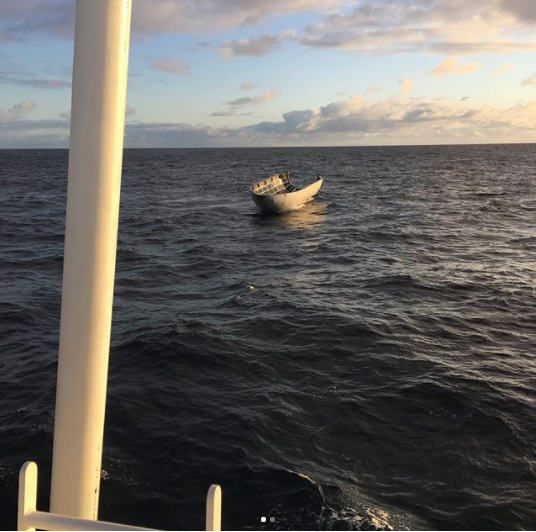Mr. Steven, the boat that will catch SpaceX Falcon 9 fairings as they return to Earth. Image: Elon Musk/Instagram
Early Thursday morning, a SpaceX Falcon 9 rocket lifted off from Vandenberg Air Force base carrying two telecommunication satellites to Low Earth Orbit. Those satellites are testing the viability of Starlink, Elon Musk’s plan to cover every inch of the Earth with satellite broadband. It’s the first step toward making this highly ambitious (and historically ill-fated) project a reality, but the launch was also remarkable for what happened after the satellites were deployed in orbit.Off the California coast, a boat called 205-foot boat called Mr. Steven, owned by a company called SeaTran, attempted to catch the Falcon 9’s fairing (the casing on the top of the rocket that holds its payload) as it fell back to Earth. According to a Tweet from Musk, the boat missed the fairing "by a few hundred meters.""Fairing landed intact in the water," Musk tweeted. "Should be able to catch it with slightly bigger chutes to slow down descent." As Musk described the boat that was supposed to catch the fairing on Instagram, it’s “basically a giant catcher’s mitt." The fairing, which returned to Earth as two separate halves falling at eight times the speed of sound (over 6,000 miles per hour), wasn't going to hit the boat at that speed, but the halves were slowed by parachutes as they approached the surface.Now that SpaceX can land its first stage boosters, it has turned its attention to recovering fairings in similar manner. Unlike the fairings used on previous Falcon 9 launches, the one used today has a guidance system and thrusters to help guide it to the boat on the ocean.Read More: Check Out Motherboard’s Photos from the SpaceX Falcon Heavy Launch PadThis system has been tested once before. Last March, SpaceX tested the fairing’s thruster system and parachute to safely land the fairing in the Atlantic Ocean, although the fairing wasn’t returned to land.Each fairing is worth about $6 million, so the ability to recover and reuse a rocket fairing is a big money-saver for SpaceX. Once the fairing recovery system is perfected, the only expendable part on Falcon 9 rockets will be the upper stage. Musk told me on Twitter that the next payload fairing recovery attempt would occur in "about a month."
As Musk described the boat that was supposed to catch the fairing on Instagram, it’s “basically a giant catcher’s mitt." The fairing, which returned to Earth as two separate halves falling at eight times the speed of sound (over 6,000 miles per hour), wasn't going to hit the boat at that speed, but the halves were slowed by parachutes as they approached the surface.Now that SpaceX can land its first stage boosters, it has turned its attention to recovering fairings in similar manner. Unlike the fairings used on previous Falcon 9 launches, the one used today has a guidance system and thrusters to help guide it to the boat on the ocean.Read More: Check Out Motherboard’s Photos from the SpaceX Falcon Heavy Launch PadThis system has been tested once before. Last March, SpaceX tested the fairing’s thruster system and parachute to safely land the fairing in the Atlantic Ocean, although the fairing wasn’t returned to land.Each fairing is worth about $6 million, so the ability to recover and reuse a rocket fairing is a big money-saver for SpaceX. Once the fairing recovery system is perfected, the only expendable part on Falcon 9 rockets will be the upper stage. Musk told me on Twitter that the next payload fairing recovery attempt would occur in "about a month."
Advertisement

